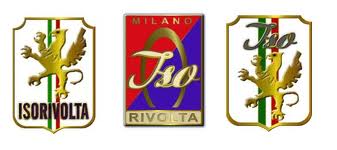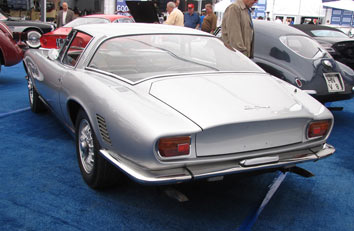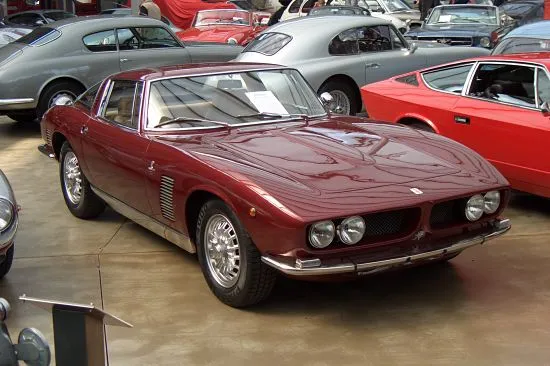Iso Tyres



Classic Iso Tyres
On the following pages, Longstone Classic Tyres give classic tyre fitment recommendations for Iso cars.
If your car is not listed, don't panic! Please give us a call on:
01302 711 123
or
Email: sales@longstonetyres.co.uk
Iso Fidia Tyres
The Iso Fidia fitted the 205 VR 15 PIRELLI CINTURATO CN72. We still have this tyre available for the Iso Fidia.
Iso History
ISO Rivolta began as Isothermos of Bolzaneto, a plant making electric heaters and chillers that was bought by the engineer Renzo Rivolta in 1939 and relocated to Bresso in 1942 when the offices were damaged in a bombing strike on Genoa. Renzo Rivolta chose to commit his firm to the manufacturing of motorcycles immediately after World War II ended, a market that generated large financial rewards at the time. One of the company's first vehicles was the Iso scooter. It was powered by a twin-cylinder engine based on the 125 Puch.

Renzo Rivolta created the notion for an automobile that was midway between a car and a motorcycle in the early 1950s, to bridge the gap between the classic motorcycle and the cheapest Italian car at the time, the Fiat Topolino. The concept was to build a motorcycle with a body in order to have a vehicle that was as affordable as a motorcycle but with the protection of a car.
The firm name was changed to Iso Autoveicoli, and the Isetta was introduced in 1953. The Isetta had a unique "egg" form and was powered by the same engine as the Isomoto 200, except it was expanded to 236 cm3 with an aluminium cylinder and chromed cane. It was a kind of cabin scooter, with four wheels (the two rear wheels were fixed, closer together) and a cockpit for two people, with just one way in: the front door, which was also planned to be the car's nose, complete with windscreen and steering wheel.
The Isetta was not a big hit in Italy. As a result, Renzo Rivolta chose to licence the idea internationally. The VELAM Isetta was created for the French market, followed by the Romi Isetta for the Brazilian and South American markets in general, and finally the BMW Isetta. Due to an unfortunate post-war restructuring and the failure of its high-end models after the war, the Bavarian firm was far from robust. The BMW 250, i.e., the BMW-branded Isetta, was significantly more successful in Germany than in Italy. In the end, 160,000 units were manufactured and sold.

The Iso Isetta's manufacture ended at the end of 1956. Meanwhile, the Bresso-based business created the Iso 400, a more conventional compact automobile with a three-volume body that remained in prototype form. Iso's operations in the sectors of microcars and motorcycles came to a stop in early 1957. Renzo Rivolta wanted to go in a different path, so he formed Iso Rivolta from the ashes of Iso Autoveicoli, a vehicle manufacturer targeting the small market of high-end Gran Turismos, with production midway between the GTs of the German or American schools and the GTs of the Italian school.
The Iso Rivolta IR 300, a luxury coupé built by Bertone (through Giorgetto Giugiaro's drawings) with a chassis constructed by Eng. Giulio Alfieri and powered by a V8 engine from a Chevrolet Corvette, marked the official shift to passenger vehicle manufacturing in 1962. The number 300 in the name denoted the engine's horsepower: 300 hp. It was also evident at that point what type of automobiles the Iso would build: high-performance grand touring cars with top-tier finishes.
The Iso A3 was manufactured in 1963 and displayed on the Iso Rivolta booth at the Turin Auto Show. It was handed to Giotto Bizzarrini, who was employed by Iso as a track engineer and was intended for racing with the acronym A3/C. The bodywork, on the other hand, was built using 1,700 rivets at Piero Drogo's Carrozzeria Sports Cars in Modena. Indeed, the second Iso model was dubbed "millechiodi", which roughly translates to 'A Thousand Nails'.
The firm began manufacturing of a new portfolio of cars based on the GT 300 chassis with the launch of sales in the United States and the signing of a permanent powertrain deal with General Motors. The result was the Grifo sports coupé (1965), with engines ranging from 5.4 to 7 litres, the Fidia luxury saloon (1968), and the Lele 2+2 grand tourer (1969), all created by Marcello Gandini, Bertone's main designer.
By the end of 1971, the firm had chosen Ford Cleveland engines owing to the unfavourable economic conditions imposed by GM (requiring upfront payment for the engines, which had to be acquired in bulk). Competition from prominent companies, particularly Maserati and Aston Martin (but also, for some models, Ferrari and Lamborghini), as well as the 1973 oil crisis, placed Iso Rivolta's financial future in peril.
The Rivolta family floated the firm on the New York Stock Exchange in early 1973. The Iso-Marlboro Formula 1 team was formed as a result of an arrangement by Philip Morris and the young team manager Frank Williams. Due to the acquisition of stock exchange shares by the Italian-American Iso Pera, the company's name was changed to Iso Motors & Co. The Rivolta family finally relinquished control after producing 10,000 ISO snowmobiles. The costs of managing the team, the drop in sales caused by the economic and social crises in the first half of the 1970s, and market conditions in the United States, all contributed to the end of car production on December 31, 1974.
ISO Griffo Tyre Recommendation
The Pirelli classic tyre collection isn't 50-year-old technology--it's actually modern tyre construction, made of entirely different, modern materials wrapped in a skin that has the same sidewall look and tread pattern as the originals. But it is absolutely not merely a 50-year-old reproduction of an obsolete technology, and your car will ride and handle the way the factory designed it to with these tyres. They're amazing, and ride superbly! You're not only getting the correct size tyre that was engineered to work in concert with the rest of your suspension, along with the correct tyre fitment and look for your 1960s classic, but you're also getting the best tyre for the car. As I've said before, fitting the Pirelli HS CN72 20VR-15 tyres to my Grifo was the single best thing I ever did to enhance the driving pleasure of owning my car. Coker Tyre doesn't carry these tyres. You can get them from Longstone Tyres in England and from Lucas Tyres in the States, which is a direct connection to the Pirelli factory. Regardless of where you get them, I highly recommend these tyres to all Iso owners, with absolutely no reservations (and I've tried lots of other tyres on my Grifo, and these are head and shoulders above the rest, and worth every penny they cost). They are simply the best you can purchase, for driving and showing (and I don't show much anymore, just DRIVE! all the time).
